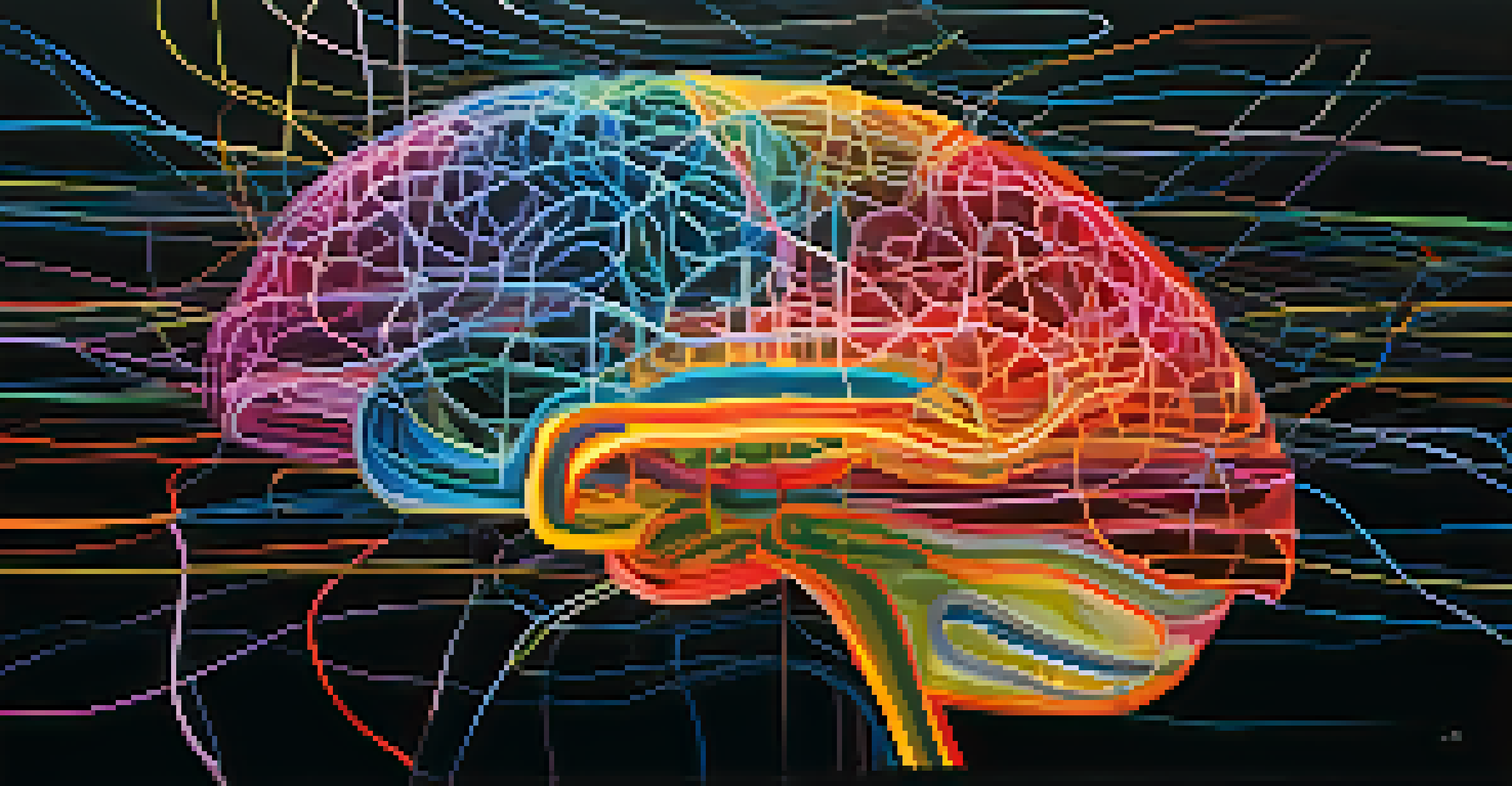Hallucinogens and the DMN: Therapeutic Potential Explored

Understanding Hallucinogens and Their Effects
Hallucinogens are substances that significantly alter perception, mood, and cognitive processes. Common examples include LSD, psilocybin (found in magic mushrooms), and ayahuasca. These compounds can lead to experiences that might feel dreamlike or surreal, often accompanied by visual or auditory hallucinations.
The greatest discovery of my generation is that a human being can alter his life by altering his attitude of mind.
The effects of hallucinogens can vary widely, depending on factors such as dosage, individual psychology, and setting. Some users report profound insights or a sense of interconnectedness, while others may experience anxiety or paranoia. This duality in experiences makes them a fascinating subject for research, particularly in therapeutic settings.
In recent years, there has been a resurgence of interest in the therapeutic potential of hallucinogens, especially for mental health conditions like depression, PTSD, and anxiety. Researchers are keen to understand how these substances interact with brain networks to promote healing and personal growth.
What is the Default Mode Network (DMN)?
The Default Mode Network (DMN) is a network of brain regions that is active when a person is at rest and not focused on the external environment. It plays a key role in self-referential thoughts, daydreaming, and the processing of personal memories. Essentially, it helps us reflect on ourselves and our experiences.

Research has shown that the DMN is involved in various mental health disorders. For example, in conditions like depression and anxiety, the DMN may become overly active, leading to ruminative thinking patterns. Understanding the DMN is crucial for exploring how hallucinogens might influence mental well-being.
Hallucinogens Alter Perception
Hallucinogens like LSD and psilocybin significantly change perception and mood, leading to unique psychological experiences.
Interestingly, studies suggest that hallucinogens can alter the activity and connectivity of the DMN. This alteration may help break negative thought cycles and promote a sense of unity with oneself and the universe, which is often reported by users of these substances.
The Connection Between Hallucinogens and the DMN
Research indicates that hallucinogens can significantly modulate the activity of the DMN, leading to changes in consciousness and perception. When under the influence of these substances, individuals often experience a decrease in the activity of the DMN, which is associated with reduced self-referential thinking.
We do not see things as they are, we see them as we are.
This decrease in DMN activity can lead to what many describe as a 'loss of ego,' allowing individuals to step outside of their usual thought patterns. By quieting the DMN, hallucinogens may create space for new perspectives and insights to emerge, which is particularly beneficial in therapeutic contexts.
Moreover, the ability of hallucinogens to temporarily disrupt entrenched neural pathways in the DMN may help facilitate breakthrough moments for individuals struggling with mental health issues. This opens up exciting possibilities for integrating these substances into treatment protocols.
Therapeutic Uses of Hallucinogens
The therapeutic potential of hallucinogens is being explored in various clinical settings. For instance, studies on psilocybin have shown promising results in treating depression and anxiety, particularly in patients who have not responded to traditional treatments. The profound experiences induced by these substances often lead to lasting positive changes in mood and behavior.
In addition to psilocybin, other hallucinogens like MDMA are being investigated for their effectiveness in treating PTSD. These substances can enhance emotional processing and help individuals confront traumatic memories in a safe environment, potentially leading to significant healing.
DMN's Role in Mental Health
The Default Mode Network (DMN) is linked to self-referential thinking, and its modulation by hallucinogens may help alleviate mental health issues.
As research continues to evolve, there is a growing recognition of the need for structured and supervised settings when using hallucinogens for therapeutic purposes. This ensures that individuals can safely navigate their experiences and integrate insights gained during treatment.
The Role of Set and Setting
When it comes to using hallucinogens therapeutically, the concepts of 'set' and 'setting' are crucial. 'Set' refers to an individual's mindset going into the experience, while 'setting' denotes the physical and social environment in which the experience takes place. Both can significantly influence the outcome of a hallucinogenic experience.
A positive mindset and a safe, supportive environment can enhance the therapeutic effects of hallucinogens. Conversely, a negative mindset or an uncomfortable setting can lead to challenging experiences or even psychological distress. This highlights the importance of preparation and guidance in therapeutic settings.
Understanding these factors can help clinicians create optimal conditions for patients. By fostering a supportive atmosphere and encouraging positive expectations, the therapeutic potential of hallucinogens can be maximized.
Potential Risks and Considerations
While hallucinogens show promising therapeutic potential, they are not without risks. Individuals with a personal or family history of psychosis may be at an increased risk of experiencing negative psychological effects. It's essential for clinicians to screen for these risks before recommending hallucinogenic treatments.
Additionally, the unpredictability of hallucinogenic experiences can lead to discomfort or anxiety for some individuals. It's vital that patients are well-informed about what to expect and have access to support during and after their experiences.
Therapeutic Potential of Hallucinogens
Research is increasingly recognizing the therapeutic benefits of hallucinogens for conditions such as depression and PTSD, particularly in controlled settings.
As research progresses, establishing clear guidelines and protocols for the safe use of hallucinogens in therapy will be crucial. This ensures that the benefits can be harnessed while minimizing potential harms.
The Future of Hallucinogens in Mental Health Treatment
As the stigma surrounding hallucinogens diminishes, the future looks bright for their integration into mental health treatment. Ongoing research continues to unveil the mechanisms through which these substances interact with the brain, offering hope for new therapeutic approaches. The potential to treat conditions that have long been deemed difficult to manage is particularly exciting.
Moreover, the growing interest in holistic and integrative approaches to mental health aligns well with the therapeutic use of hallucinogens. Many individuals are seeking alternatives to traditional medications, and hallucinogens could provide a complementary option that emphasizes personal insight and healing.

In conclusion, the exploration of hallucinogens and their impact on the DMN represents a significant frontier in mental health research. As we continue to learn and understand their potential, we may unlock new pathways to healing and well-being.